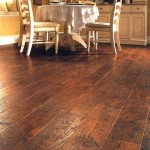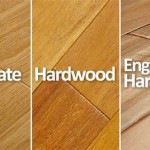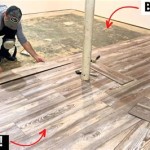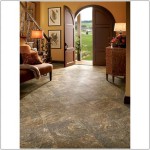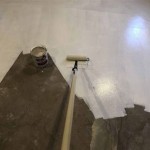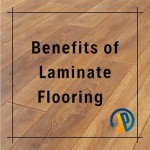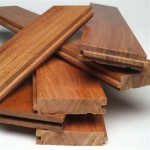What Are The Pros And Cons Of Putting Vinyl Flooring Over Hardwood?
The decision of whether to install vinyl flooring directly over existing hardwood floors is a common consideration for homeowners seeking to update the aesthetic or improve the functionality of their spaces. This approach presents a potential shortcut compared to the more involved process of hardwood removal. However, it's crucial to thoroughly evaluate the implications before proceeding. Both advantages and disadvantages must be weighed carefully to ensure a satisfactory outcome that avoids future problems and maximizes the lifespan of both the vinyl and the underlying hardwood.
Installing vinyl over hardwood can be an attractive option due to its perceived cost-effectiveness and ease of installation. It allows for a quicker renovation process, minimizing disruption to daily life. Vinyl flooring itself offers a wide range of styles and textures, including realistic wood-look options, providing homeowners with considerable design flexibility. Furthermore, vinyl is generally more water-resistant than hardwood, making it a suitable choice for areas prone to moisture.
However, covering hardwood with vinyl isn’t without its risks. The presence of existing imperfections in the hardwood, such as unevenness or loose boards, can telegraph through the vinyl, compromising its appearance and potentially leading to premature wear. Trapped moisture between the two flooring materials can create an environment conducive to mold and mildew growth, damaging both floors and potentially impacting indoor air quality. Moreover, covering hardwood might devalue the property, as potential future buyers may prefer the original hardwood flooring.
Cost and Installation Considerations
One of the primary drivers behind choosing to install vinyl over hardwood is often cost savings. The expense of removing the existing hardwood can be significant, involving labor costs, disposal fees, and potential repairs to the subfloor. By bypassing this step, homeowners can potentially reduce the overall renovation budget. Installation of vinyl flooring, particularly click-lock or peel-and-stick varieties, can often be a do-it-yourself project, further reducing costs.
However, it's imperative to factor in potential costs associated with preparing the hardwood surface. If the hardwood is uneven or has significant damage, patching and leveling may be necessary. This preparation can add to the project's expense and labor requirements. Furthermore, if the vinyl flooring requires professional installation, comparing the cost of installing vinyl over prepared hardwood to the cost of hardwood removal and vinyl installation is essential to determine the most economical approach.
The installation process itself can be relatively straightforward, depending on the type of vinyl flooring chosen. Click-lock vinyl planks or tiles offer a floating floor system that doesn't require adhesives, simplifying installation. Peel-and-stick vinyl is even easier to install, requiring only proper surface preparation. However, sheet vinyl generally requires professional installation to ensure a seamless and watertight finish. Proper surface preparation is paramount, regardless of the type of vinyl chosen. The hardwood floor must be clean, dry, and level to ensure the vinyl adheres properly and avoids future problems.
Moisture and Subfloor Integrity
Moisture is a critical factor to consider when evaluating the suitability of installing vinyl over hardwood. Hardwood is a porous material that can absorb moisture from the environment. If moisture is already present in the hardwood or if moisture is introduced after the vinyl is installed, it can become trapped between the two flooring materials. This trapped moisture can lead to the growth of mold and mildew, which can damage both the hardwood and the vinyl, and pose health risks to occupants.
Before installing vinyl, it is essential to thoroughly inspect the hardwood for signs of moisture damage, such as cupping, warping, or discoloration. Addressing any existing moisture issues is crucial before proceeding. This may involve repairing leaks, improving ventilation, or using a dehumidifier to reduce humidity levels. A moisture barrier or underlayment designed to prevent moisture migration should be considered, especially in areas prone to humidity or spills.
The condition of the subfloor beneath the hardwood is also an important consideration. A weak or damaged subfloor can compromise the stability of both the hardwood and the vinyl flooring. If the subfloor is not structurally sound, it may need to be repaired or replaced before installing the vinyl. Ignoring subfloor issues can lead to problems such as squeaking, unevenness, and premature wear of the vinyl flooring.
Long-Term Implications and Property Value
Installing vinyl over hardwood can have long-term consequences for both the flooring materials and the property value. While vinyl flooring is durable and water-resistant, it is not impervious to damage. Scratches, dents, and tears can occur over time, especially in high-traffic areas. Replacing damaged vinyl flooring can be more challenging when it is installed over hardwood, as removing the vinyl without damaging the underlying hardwood may be difficult.
Furthermore, covering hardwood floors can potentially devalue the property. Hardwood floors are often considered a desirable feature, and many homebuyers are willing to pay a premium for properties with hardwood. Covering the hardwood with vinyl may be viewed as a negative by potential buyers, who may perceive it as a sign that the hardwood is damaged or of poor quality. While some buyers may appreciate the look and functionality of the vinyl flooring, others may prefer to have the option of restoring the original hardwood. Removing the vinyl to reveal the hardwood can be a costly and time-consuming process, which can deter potential buyers.
The long-term maintenance of vinyl flooring installed over hardwood also requires careful consideration. While vinyl is relatively easy to clean, certain cleaning products and methods can damage its surface. Using abrasive cleaners or excessive amounts of water can dull the finish and potentially lead to moisture penetration. It is important to follow the manufacturer's recommendations for cleaning and maintaining the vinyl flooring to ensure its longevity and preserve its appearance. Regular inspections should be conducted to identify and address any potential problems, such as loose seams or damaged areas, before they escalate.
Another element to consider is the potential for off-gassing from the vinyl flooring. Some vinyl products may release volatile organic compounds (VOCs) into the air, which can have negative health effects. Choosing low-VOC or phthalate-free vinyl flooring can help to minimize this risk. Proper ventilation during and after installation is also important to dissipate any VOCs that may be released.

Vinyl Vs Hardwood Flooring Which One Is Right For You Wide Plank Floor Supply

Installing Luxury Vinyl Flooring Over Original Hardwood Pros And Cons

Hardwood Vs Vinyl Flooring Pros Cons Comparisons And Costs Fixr

Luxury Vinyl Flooring Pros And Cons Reallyfloors America S Est Hardwood

How To Install Vinyl Flooring Over Hardwood Floors Wood Floor Fitting

The Pros And Cons Of Rigid Core Vinyl Flooring

Pros And Cons Of Vinyl Flooring Options At Home Asterra

Vinyl Wood Plank Flooring Vs Hardwood Pros Cons Comparison

Considering Luxury Vinyl Flooring Over Original Hardwood Pros And Cons
What Is Lvp Flooring Thumbtack Com
See Also
